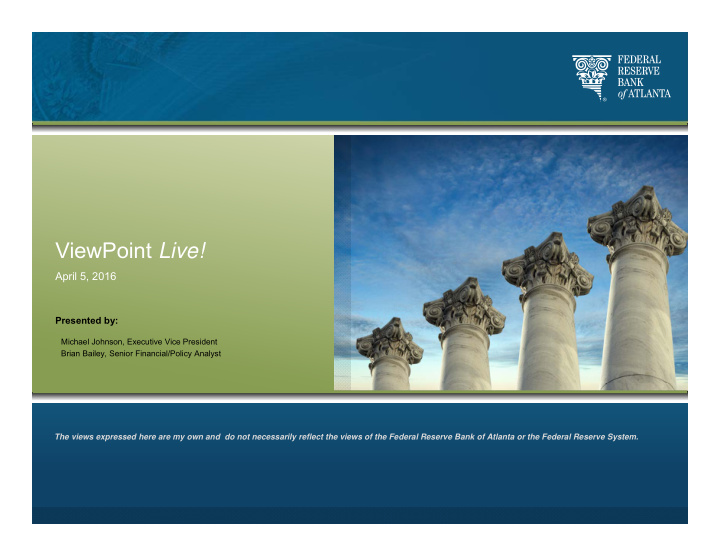



ViewPoint Live! April 5, 2016 Presented by: Michael Johnson, Executive Vice President Brian Bailey, Senior Financial/Policy Analyst The views expressed here are my own and do not necessarily reflect the views of the Federal Reserve Bank of Atlanta or the Federal Reserve System.
Current U.S . Banking Conditions Source: Bank Call Reports 2
Recent Guidance Pertaining to CRE Lending SR 16-5 Interagency Advisory on Use of Evaluations in Real Estate-Related Financial Transactions SR 15-17 Interagency Statement on Prudent Risk Management for Commercial Real Estate Lending http:/ / www.federalreserve.gov/ bankinforeg/ srletters/ srletters.htm 3
Trends in CRE National CRE Vacancy Rates CRE Loans Outstanding at Banks Source: AXIOMetrics/CBRE-EA/FRB Atlanta Risk Analysis Unit. National CRE Price Growth Foreign Capital Invested in U.S. CRE Source: Real Capital Analytics/FRB Atlanta Risk Analysis Unit. Source: Real Capital Analytics/CoStar /FRB Atlanta Risk Analysis Unit.
Apartment Occupancy • Occupancy levels remain at historically robust levels • National Occupancy Rate: 94.9% • Apartment Occupancy levels are encountering headwinds due to: 1) Energy Sector Declines 2) Greater Levels of New Supply • Occupancy levels for Class A, B & C properties range from 93-95% Source: AXIOMetrics, Risk Analysis Unit/Federal Reserve Bank of Atlanta
Apartment Change in Occupancy The decline in occupancy can be attributed to: 1) Energy Sector 2) Greater Supply 3) Off-peak Leasing Season Areas directly impacted by the decline in the Energy Sector 1) South Central 2) Rockies 3) Upper Plains Source: AXIOMetrics, Risk Analysis Unit/Federal Reserve Bank of Atlanta
Apartment Effective Rent Growth Effective Rent Growth: (Asking Rent minus Concessions) Strong Areas: 1) Coastal Markets 2) Eastern Sunbelt 3) Arizona Weak Areas: Generally Energy Dependent 1) South Central (LA, OK, portions TX) 2) Upper Plains (ND) 3) Eastern Rockies (WY, CO) Source: AXIOMetrics, Risk Analysis Unit/Federal Reserve Bank of Atlanta
S ixth District CRE Trends - Apartments Vacancy Rates 50% 31% 25% • Apartment Vacancy Rates in most Sixth 0% District markets are significantly below -25% -18% 4Q each market’s long-term average -23% -28% -29% -31% -33% -50% -37% -38% -40% 8Q (except Birmingham). -45% • Generally across the District, Apartment Vacancy Rates continue to decline, which is indicative of improving conditions. Completion Rates • Completion rates are above their long- term averages in: 50% 29% 21% 25% 10% 5% 1) Birmingham 0% 2) Fort Lauderdale -2% -7% -25% 3) Nashville -12% -19% 4Q -21% -22% -28% -50% 8Q Source: AXIOMetrics, Risk Analysis Unit/Federal Reserve Bank of Atlanta
S ixth District CRE Trends - Office Vacancy Rates 50% 32% 25% 25% 12% 7% 0% • Office Vacancy Rates in most Sixth -8% -9% District markets are below each -12% -25% 4Q -5% -13% -11% market’s long-term average (except -31% 8Q -50% Birmingham, New Orleans, Orlando). • Downward 4Q Trend in Vacancy indicates improving conditions. • At the same time, Rates of Office Completion Rates Completions show mixed results. 50% 25% 10% 2% 0% -9% -25% 4Q -20% -22% -22% -23% -26% -28% -28% -30% -50% 8Q Source: CBRE-EA/ Risk Analysis Unit/Federal Reserve Bank of Atlanta
S ixth District CRE Trends - Industrial Vacancy Rates 50% 16% 25% 7% 0% • Across the District, Industrial Vacancy -10% -12% 4Q Rates continue to decline which is -25% -4% -21% -23% indicative of resilient conditions. -28% 8Q -39% -50% -44% -47% • Except New Orleans, the 4Q trend indicates further improvement in vacancy rates. • Except for New Orleans, Orlando and Completion Rates Tampa, 4Q trend data indicates that a number of markets are seeing a pick-up 0% in new construction and completion rates are moving back toward their long- term average. -15% -15% -19% -25% -21% -21% -22% -25% -25% -26% -29% -25% 4Q 8Q -50% Source: CBRE-EA/ Risk Analysis Unit/Federal Reserve Bank of Atlanta Notes: Availability rates are used as a proxy for vacancy rates in Birmingham and New Orleans Birmingham's completion rates are estimated using the completion and stock values provided by CBRE.
S ixth District CRE Trends - Retail Vacancy Rates 21% 25% 15% 9% 6% 2% 2% 2% 0% • Retail Vacancy Rates in most Sixth -2% -3% District markets are near or above each -5% 4Q market’s long-term average. 8Q -25% • Fort Lauderdale and West Palm Beach are experiencing heightened levels of vacancy. • Generally across the District, Retail Vacancy Rates continue to decline which Completion Rates is indicative of improving conditions. 0% • At the same time, Rates of Retail Completions show most markets are -13% -13% -16% significantly below their long-term -25% -20% -22% -24% averages. -25% -26% -26% -28% 4Q 8Q -50% Source: CBRE-EA/ Risk Analysis Unit/Federal Reserve Bank of Atlanta
Takeaways • Continued improvements in the U.S. Economy have translated into improving fundamentals; however, performance is highly dependent property, location, class, etc. • Continued improving fundamentals and the robust availability of capital have translated into heightened pricing levels and rates of growth; however, recent data indicates the trends maybe slowing. • Local economic conditions are causing conditions to moderate in some Apartment markets. These markets generally have a significant exposure to Energy-related industries and jobs. • Most Sixth District markets continue to experience improving Commercial Real Estate conditions; however, market dynamics are indicating that rates of new supply may accelerate. Disciplined lending is essential during periods of accelerating and robust market conditions.
Thank you Additional Fed Resources: Community Banking Connections https:/ / communitybankingconnections.org/ ViewPoint https:/ / frbatlanta.org/ economy-matters.aspx S tress Tests and Capital Planning http:/ / federalreserve.gov/ bankinforeg/ stress-tests-capital-planning.htm Basel Regulatory Framework http:/ / federalreserve.gov/ bankinforeg/ basel/ default.htm Presented by: S upervision and Regulation/ Consumer Affairs Letters http:/ / federalreserve.gov/ bankinforeg/ srletters/ srletters.htm http:/ / federalreserve.gov/ bankinforeg/ caletters/ caletters.htm Economic, Banking and Financial Data http:/ / federalreserve.gov/ econresdata/ default.htm https:/ / research.stlouisfed.org/ fred2/ The views expressed here are my own and do not necessarily reflect the views of the Federal Reserve Bank of Atlanta or the Federal Reserve System.
Recommend
More recommend